Recent years have seen an increase in the number of NCEs to gain regulatory approval in Europe, and 2014 was no exception. Once again, many are treatments for different types of cancers, and a large number of orphan drugs also got the go-ahead.
Four different products designed to treat hepatitis C infection were approved. For many years treatment for HCV relied on year-long dosing of the antiviral drug ribavirin alongside an interferon, but side-effects caused by this combination are significant, and there is no guarantee that it will actually clear the virus from the bloodstream. But following on from the treatment-changing drugs that have reached the market recently, notably Gilead’s sofusbuvir (Sovaldi), other companies have been getting in on the act.
Two of the four new approvals come from AbbVie, in the shape of dasabuvir (Exciera) and the combination of ombitasvir and paritaprevir along with ritonavir, marketed under the name Viekirax. The other two new drugs are simeprevir (Janssen’s Olysio) and daclatasvir (Daklinza, Bristol-Myers Squibb). All act at serine protease targets on the virus: simeprevir and paritaprevir at NS3/4A, daclatasvir and obitasvir at NS5A, and dasabuvir at NS5B, the same mechanism as sofusbuvir.
All are designed to offer a shorter treatment time and side-effect profiles that have a lower impact on the patient’s quality of life. While not all patients have a genotype of the virus that is susceptible to these drugs, they represent a significant advance in the treatment of this chronic disease, and preventing the diseases, such as cirrhosis and liver cancer, that all too often afflict those with HCV infection down the line.
One other new anti-infective got the go-ahead – dalbavancin (Xydalba) from Durata. Dalbavancin is a second generation lipoglycopeptide compound that interrupts cell wall synthesis in some Gram positive bacteria. It is in the same class as vancomycin, and is active against MRSA. It is now part of the Actavis portfolio, after the company’s acquisition of Durata last year.
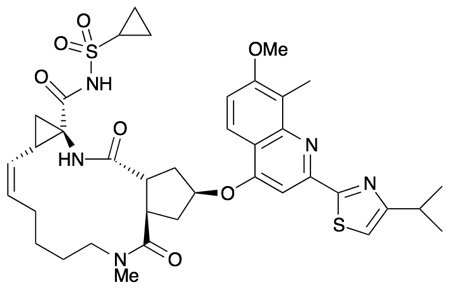
Simeprevir
Psoriasis patients remain short of treatment options, and two more immunosuppressant drugs with this indication were approved – one a small molecule, and the other a monoclonal antibody. The antibody, secukinumab (Cosentyx, Novartis) is a fully human IgG1/κ monoclonal antibody that selectively binds to the proinflammatory cytokine interleukin 17A, and neutralises it. This inhibits the release of other inflammatory molecules, including cytokines and chemokines.
Apremilast (Otezla, Celgene), meanwhile, is an orally available small molecule inhibitor of phosphodiesterase 4. This modulates a network of pro-inflammatory and anti-inflammatory mediators, ultimately affecting the expression of IL-17, IL-23A and tumour necrosis factor alpha, among others.
Another anti-inflammatory monoclonal antibody, Takeda’s vedolizumab (Entyvio), is now available for the treatment of Crohn’s disease and ulcerative colitis. It is a humanised immunoglobulin G1 against the human lymphocyte integrin α4β7. This integrin is expressed on the surface of some memory T lymphocytes that naturally migrate to the gastrointestinal tract, causing inflammation. The antibody prevents this by inhibiting these cells’ adhesion to mucosal addressin cell adhesion molecule 1, or MAdCAM-1, stopping them from transmigrating into inflamed parenchymal tissue.
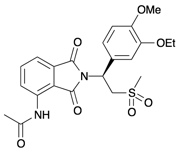
Apremilast
About a third of 2014’s approvals are for cancer indications. Tyrosine kinases continue to be important as cancer targets, and many drugs aimed at them are both marketed and in development. For example, the human receptor targeted antibody ramucirumab (Cyramza, Lilly) binds VEGF receptor 2, and inhibits angiogenesis via binding to VEGF-A, VEGF-B and VEGF-D. It has been approved to treat patients with gastric cancer or gastro-oesophageal junction adenocarcinoma, either as monotherapy or in combination with paclitaxel.
Boehringer Ingelheim’s nintedanib (Vargatef) is licensed for non-small cell lung cancer in combination with docetaxel, and is a small molecule inhibitor of VEGF 1-3, platelet derived growth factor receptors α and β, and fibroblast growth factor receptors 1–3. A couple of months later, it was recommended for the treatment of idiopathic pulmonary fibrosis, an orphan indication, under the brand name Ofev.
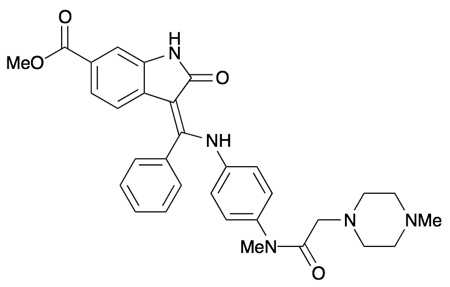
Nintedanib
GSK’s trametinib (Mekinist) is a first-in-class drug designed to treat melanoma with a BRAF V600 mutation. It inhibits mitogen-activated extracellular signal regulated kinases 1 and 2 (MEK1 and MEK2). About half of all melanoma patients have the mutation that renders their cancer susceptible.
Olaparib (Lynparza, AstraZeneca) is a small molecule inhibitor of human poly(ADP ribose) polymerase enzymes PARP-1, PARP-2 and PARP-3. These are required for the repair of DNA single strand breaks; an alternative repair pathway is possible in cancers with functional BRCA1 and BRCA2 genes, but this does not work if these genes do not function. Thus, PARP inhibition is an effective tool against such tumours. Olaparib is licensed for treatment of ovarian, fallopian tube and primary peritoneal cancers in women with BRCA mutations.
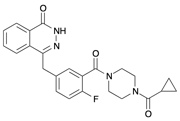
Olaparib
Another new treatment for ovarian cancer, Endocyte’s vintafolide (Vyfinit) has been approved alongside two companion diagnostics, etarfolatide (Folcepri) and neocepri (folic acid). First, folic acid is administered, then the diagnostic etarfolatide, a technetium-99m chelating peptide. This binds to the folate receptor expressed on the surface of cancers such as ovarian cancers, and single photon emission computed tomography imaging can then be used to determine whether an ovarian cancer patient is likely to respond to vintafolide. This drug is a combination of folic acid and the vinca alkaloid cytotoxic agent desacetylvinblastine hydrazide. The folic acid assists in accurate delivery to cancer cells that express folate receptors, where it inhibits microtubule assembly and arrests cells in mitosis.
Neutropenia is a common side-effect of cancer treatments, and Teva’s balugrastim (Egranli) is an immunostimulator that regulates the production and release of functional neutrophils from the bone marrow. This reduces the severity of neutropenia symptoms and the incidence of febrile neutropenia following cytotoxic chemotherapy.
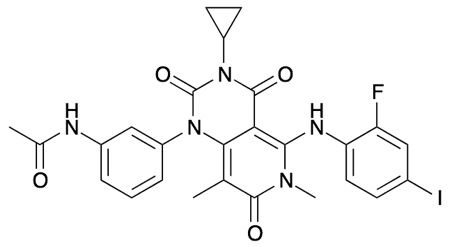
Trametinib
Growing importance of diagnostics
Diagnostics can be extremely important in the detection of cancers and monitoring their progress. Navidea Biopharmaceuticals’ technetium Tc99m tilmanocept (Lymphoseek) is such a product. The diagnostic radiopharma-ceutical specifically binds to CD206 mannose binding receptor proteins on the surface of macrophages and dendritic cells in the tumour draining lymph nodes, otherwise known as sentinel lymph nodes, enabling them to be visualised. It is indicated in patients with breast cancer, melanoma and localised squamous cell carcinoma of the oral cavity.
Four new drugs were approved to treat blood cancers. Obinutuzumab (Gazyvaro, Roche) is licensed for the first-line treatment of chronic lymphocytic leukaemia (CLL), in combination with chlorambucil. The recombinant monoclonal antibody targets the CD20 transmembrane antigen on the surface of both non-malignant pre-B and mature B-lymphocytes. It is thought to direct cell death and mediate both antibody dependent cellular cytotoxicity and antibody dependent cellular phagocytosis.
Janssen’s ibrutinib (Imbruvica) is the first Bruton’s tyrosine kinase (Btk) inhibitor to reach the market, and is licensed for both CLL and mantle cell lymphoma. Btk is a signalling molecule of the B-cell antigen receptor and cytokine receptor pathways.
Another first-in-class drug, idelalisib (Zydelig) from Gilead, has been approved to treat CLL and follicular lymphoma. This molecule inhibits phosphatidylinositol 3 kinase p110d, which is important in various different signalling pathways that drive the proliferation, survival, homing and retention of malignant cells in lymphoid tissues and bone marrow. The kinase is hyperactive in B-cell malignancies.
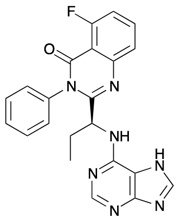
Idelalisib
Another antibody has been licensed for the treatment of multicentric Castleman’s disease which, while not cancerous, involves the growth of the lymph nodes and related tissues. Patients are left with increased risk of infection, kidney failure and various cancers. Siltuximab is a human-mouse chimeric monoclonal antibody that binds and neutralises human IL-6, improving symptoms and reducing tumour burden.
Two new agents were approved to treat a very different blood disorder, haemophilia. Octapharma’s simoctocog alfa (Nuwiq) is a recombinant blood coagulation factor VIII for use in patients with haemophilia A, who have a congenital deficiency in this factor. This replacement therapy is designed to increase plasma levels of factor VIII in those with a deficiency, and thereby prevent the tendency for bleeding.
Haemophilia B is the target disease of Baxter’s nonacog gamma (Rixubis), a congenital condition in which patients have a deficiency in factor IX. When this factor is activated, in tandem with activated factor VIII, it activates factor X to convert prothrombin into thrombin.
Vorapaxar (Zontivity, Merck Sharp & Dohme) was developed to reduce atherothrombotic events in patients with a history of myocardial infarction, and is recommended to be administered alongside aspirin and, if appropriate, clopidogrel. It is a selective and reversible inhibitor of the protease activated receptor 1 that is present on platelets activated by thrombin. This prevents platelet aggregation without affecting coagulation.
The rising incidence of Type II diabetes in the general population has made it a very fertile field for pharmaceutical innovation, with multiple members of different therapeutic classes gaining EU approval in 2014. For example, empagliflozin (Jardiance) from Boehringer Ingelheim blocks the activity of sodium glucose co-transporter 2, or SGLT2. This has the effect of reducing the reabsorption of glucose in the kidney, leaving it to be excreted in the urine. The result is a lowering of glucose levels in the bloodstream.
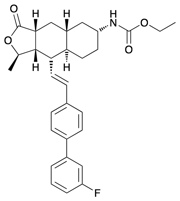
Vorapaxar
Two new glucagon-like peptide 1, or GLP-1, receptor agonists were approved. GLP-1 enhances the secretion of insulin in response to glucose, but it has a short half-life. Albiglutide (Eperzan, GlaxoSmithKline) was created by fusing a GLP-1 analogue to albumin, and has a much longer half-life.
Similarly, Lilly’s dulaglutide (Trulicity), is a GLP-1 receptor agonist with an extended half life; this time, the GLP-1 analogue is fused to a modified human immunoglobulin fragment. Also reaching the market in this class is Xultophy from Novo Nordisk, which combines the already-approved liraglutide with insulin degludec.
Unmet medical need
Schizophrenia is a real area of unmet medical need, and a new product from Takeda, lurasidone (Latuda) offers another treatment option. The antipsychotic drug blocks the effects of dopamine and monoamine by binding to dopamine D2 and both 5-HT1A and 5-HT7 serotonin receptors. This affects brain activity, reducing psychotic symptoms.
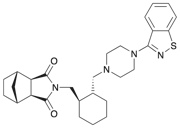
Lurasidone
A new therapy for Parkinson’s disease, Zambon’s safinamide (Xadago), is a selective, reversible mono-amineoxidase-B inhibitor that causes an increase in the extracellular levels of dopamine in the striatum. It also has a state-dependent inhibitory effect on voltage gated sodium channels, and modulates a stimulated release of glutamate. It can improve symptoms in patients with motor fluctuations who are being treated with L-dopa, either with or without other Parkinson’s drugs.

Safinamide
Constipation is a common side-effect of treatment with opioid drugs, and AstraZeneca’s naloxegol (Moventig) is designed to improve this situation. It is a peripherally acting mu-opioid receptor antagonist in the gastrointestinal tract, being a pegylated form of the antagonist naloxone that binds to these receptors but cannot cross the blood-brain barrier. It therefore reduces the GI side-effects of opioid treatment while having a minimal impact on the analgesic effects.
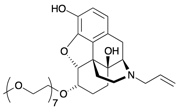
Naloxegol
Ospemifene (Senshio, Shionogi) is a selective oestrogen receptor modulator that binds to oestrogen receptors, leading to the activation of oestrogen pathways in some tissues, and their blocking in others. It is designed to treat moderate to severe symptomatic vulvar and vaginal atropy in postmenopausal women, and can improve vaginal pH levels, maturation of the vaginal epithelium, and can have beneficial effects in vaginal dryness and dyspareunia.
As has become the norm, numerous drugs to treat orphan diseases were approved. An unusual one is Clinuvel’s afamelanotide (Clinuvel), which was given marketing authorisation under exceptional circumstances to prevent phototoxicity in people with erythro-poietic protoporphyria. This rare genetic disease causes intolerance to light, with a stinging pain experienced in sun-exposed skin, and incapacitating pain for extended exposure. Afamelanotide stimulates the production of the pigment eumelanin by acting as a melanocortin-1 receptor agonist, which protects against these phototoxic reactions.
Bayer’s riociguat (Adempas) has been approved to treat chronic thrombo-embolic pulmonary hypertension and pulmonary arterial hypertension. It stimulates soluble guanylate cyclase (sGC), an enzyme within the cardiopulmonary system that acts as a receptor for nitric oxide. This NO binding event catalysts the synthesis of the signalling molecule cGMP, and the drug sensitises sGC to endogenous NO by stabilising binding, and it also directly stimulates sGC.
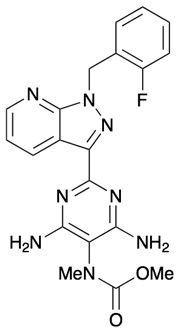
Riociguat
Many orphan conditions are inherited, and symptoms can be the result of an enzyme deficiency. Treatment therefore involves the replacement or prevents the metabolism of such enzymes, or removing their substrates. Genzyme’s eliglustat (Cerdelga) is designed to treat patients with type 1 Gaucher disease, in whom a hereditary deficiency of the enzyme glucocerebrosidase leads to an accumulation of glucosylceramide in the brain, lungs, liver, kidneys, spleen and bone marrow, resulting in a variety of complications. Eliglustat prevents the formation of glucosylceramide, via the inhibition of its synthase.
Morquio syndrome is a mucopoly-saccharide storage disease, in which the accumulation of keratan sulfate results from an inability to process mucopoly-saccharides. BioMarin’s elosulfase alfa (Vimizim) is a recombinant human N-acetyl-galactosamine-6-sulfatase, designed to replace this enzyme, whose deficiency is at the root of the disease. It is taken up into the lysosomes, where it increases the catabolism of glycosaminoglycans.
The drug ataluren (Translarna) from PTC Therapeutics, was given a conditional licence for the treatment of Duchenne muscular dystrophy. It is designed for patients with nonsense mutations in the dystrophin gene that lead to a shortened version of this protein being produced. Its action is thought to be a result of allowing the genes causing the errors to be skipped, resulting in a functional protein.
Finally, the first advanced therapy medicinal product containing stem cells got an EU approval recommendation. Chiesi’s Holoclar is a living tissue equivalent for treating limbal stem cell deficiency resulting from burns to the eye. These stem cells are found at the border between the cornea and the sclera in the eye, and if they are lost patients can experience pain, photophobia, corneal neovascularisation, inflammation and a loss of corneal transparency. Ultimately, they can go blind.
Holoclar is designed to be transplanted into the injured eye once the altered corneal epithelium has been removed, and the autologous stem cells are created from a biopsy of an undamaged part of the patient’s cornea.




